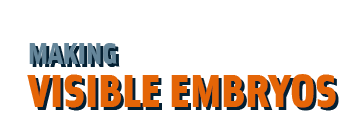How to use
The exhibition is organized thematically and roughly chronologically, in eight sections in addition to the introduction (Home) and conclusion (Visibility). Each section consists of an introduction and four (in Unborn, five) pages. Each page is composed of a main text, two thumbnail images (just one in the introductory pages) and a ‘box’ on the right-hand side containing a text and thumbnail image. Click on thumbnails for larger or more detailed images, longer captions and credits.
Pressing the ‘Resources’ buttons on each page leads to suggestions for further reading and viewing. The entire bibliography can also be accessed from the ‘Resources’ link in the top right corner.
Updates
The exhibition was first published in November 2008. A major update, which included the addition of a search tool, sitemap, period designations in the menu bar and minor changes to image captions and text, was implemented in March 2010. The update was based on comments in reviews. We thank the reviewers for their suggestions. The site underwent a largely technical update in September 2014.
Copyright
Text and design © Tatjana Buklijas and Nick Hopwood 2008–2010. All rights reserved. No part of this website may be reproduced, in any form or by any means, without the prior written permission of the authors (for text and design) or of the credited institutions and individuals (for the images).
How to cite
‘Section: Page’, Website name [url].
For example:
Tatjana Buklijas and Nick Hopwood, ‘Remodelling: Publishing in wax and print’, Making Visible Embryos [http://www.hps.cam.ac.uk/visibleembryos/s5_3.html].
Contact
Send questions and comments to: hps-embryo@lists.cam.ac.uk.
Acknowledgements
The exhibition was created by Tatjana Buklijas and Nick Hopwood and funded by a Wellcome enhancement award in the history of medicine to the Department of History and Philosophy of Science, University of Cambridge.
For extensive help with design, we are grateful to Marina Buklijas, S&T Croatia, and for technical support to Nicholas Lee, Colab Solutions, New Zealand; Marin Buric, eVision, Croatia; and David Thompson at the Department of History and Philosophy of Science.
For generous advice on the source, choice and/or interpretation of images, as well as for comments on the text, we thank: Thomas Aigner, Salim Al-Gailani, Suzanne Anker, Monica Azzolini, Richard Barnett, Soraya de Chadarevian, Judy Chelnick, William Clark, Louise Crane, Rachael Cross, Sanja Cvetnic, Zeljko Dugac, Tim Eggington, Jack Eckert, Kay Elder, John E. E. Fleming, Sarah Franklin, Cathy Gere, Scott Gilbert, Bart Grob, Kornelia Grundmann, Emma Hallam, Tim Horder, Sonia Horn, Roger Huyssen, Nick Jardine, Martin H. Johnson, Solveig Jülich, Lauren Kassell, Rina Knoeff, Lise Kvande, Sachiko Kusukawa, Hilary Marland, Lynn Morgan, Wim Mulder, Ayesha Nathoo, Signe Nipper Nielsen, Malcolm Nicolson, Silvia de Renzi, Eleanor Robson, Ulinka Rublack, Thomas Schlich, Michael Sappol, Anthea Sieveking, Bradley R. Smith, Tilli Tansey and Klaus Taschwer.
The following institutions and people have kindly supplied and/or given permission to use the images: Wellcome Library, London; Cambridge University Library; Diözesan Museum, Sankt Pölten; National Gallery, London; Bibliothèque Nationale, Paris; Museum of Natural History ‘La Specola’, Florence; Museum Anatomicum, Phillips-Universität Marburg; Vienna University Archives; Museum Boerhaave, Leiden; Medizinhistorisches Museum, Universität Zürich; Niedersächsische Staats- und Universitätsbibliothek, Göttingen; Hunterian Museum at the Royal College of Surgeons of England; Balfour and Newton Libraries, Department of Zoology, University of Cambridge; Institut für Anatomie I, Universität Jena; Tit-Meng Lim, National University of Singapore; Westminster City Archives; Ernst-Haeckel-Haus, Jena; Bildarchiv Preußischer Kulturbesitz, Berlin; Deutsches Hygiene Museum, Dresden; Staats- und Universitätsbibliothek Hamburg; Anatomisches Institut, Basel; Historical Collections, National Museum of Health and Medicine, Armed Forces Institute of Pathology, Washington, D.C.; Medizinhistorisches Institut, Universität Bern; Whipple Library, Cambridge; John Wiley & Sons, Inc.; Carnegie Institution of Washington; Special Collections of the Northwestern University, Chicago; Countway Library of Medicine, Harvard University; Bradley R. Smith, University of Michigan at Ann Arbor; British Medical Ultrasound Society; Elsevier Ltd; Getty Images; Life magazine; Lennart Nilsson Photography AB; Library of Congress; Hayes Publishing Co.; National Library of Medicine; Bourn Hall; Emma Hallam; Helen Storey Foundation; Suzanne Anker.
On the making of the exhibition see Making visible Embryos: Making a Virtual Exhibition.
Disclaimer
While every attempt has been made to contact the copyright owners for permissions to publish images, it has not been possible to do so in all cases. If you are the copyright owner of an uncredited image, please contact us at the email address above.
The authors reserve the right to make additions, changes, or corrections at any time and without notice.
We take no responsibility for the accuracy, content, or permanence of the external websites to which this one links.
Header images
The image in the header of this page, and Introduction and Resources pages, is based on Franklin P. Mall’s drawings of embryo 417, prepared ‘to assist transferring guide lines to photographs’. Carnegie Institution of Washington Archives.
The image in the header of the Visibility page is based on ‘Cubist baby’, a sculpture from Suzanne Anker’s series ‘Origins and futures’. 28’’x 39’’x 20’’.
The other header images are fully described where they appear within the sections they head.
 |
 |
